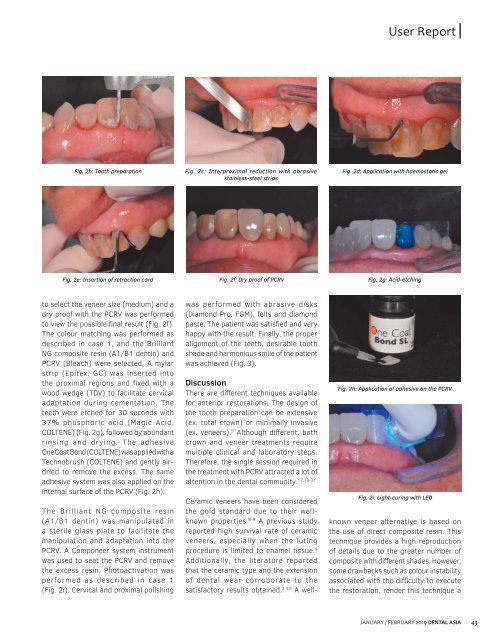Dental Asia January/February 2019
For more than two decades, Dental Asia is the premium journal in linking dental innovators and manufacturers to its rightful audience. We devote ourselves in showcasing the latest dental technology and share evidence-based clinical philosophies to serve as an educational platform to dental professionals. Our combined portfolio of print and digital media also allows us to reach a wider market and secure our position as the leading dental media in the Asia Pacific region while facilitating global interactions among our readers.
For more than two decades, Dental Asia is the premium journal in linking dental innovators
and manufacturers to its rightful audience. We devote ourselves in showcasing the latest dental technology and share evidence-based clinical philosophies to serve as an educational platform to dental professionals. Our combined portfolio of print and digital media also allows us to reach a wider market and secure our position as the leading dental media in the Asia Pacific region while facilitating global interactions among our readers.
You also want an ePaper? Increase the reach of your titles
YUMPU automatically turns print PDFs into web optimized ePapers that Google loves.
User Report<br />
Fig. 2b: Tooth preparation<br />
Fig. 2c: Interproximal reduction with abrasive<br />
stainless-steel strips<br />
Fig. 2d: Application with haemostatic gel<br />
Fig. 2e: Insertion of retraction cord<br />
Fig. 2f: Dry proof of PCRV<br />
Fig. 2g: Acid-etching<br />
to select the veneer size (medium) and a<br />
dry proof with the PCRV was performed<br />
to view the possible final result (Fig. 2f).<br />
The colour matching was performed as<br />
described in case 1, and the Brilliant<br />
NG composite resin (A1/B1 dentin) and<br />
PCRV (Bleach) were selected. A mylar<br />
strip (Epitex, GC) was inserted into<br />
the proximal regions and fixed with a<br />
wood wedge (TDV) to facilitate cervical<br />
adaptation during cementation. The<br />
teeth were etched for 30 seconds with<br />
37% phosphoric acid (Magic Acid,<br />
COLTENE) (Fig. 2g), followed by abundant<br />
rinsing and drying. The adhesive<br />
One Coat Bond (COLTENE) was applied with a<br />
Technobrush (COLTENE) and gently airdried<br />
to remove the excess. The same<br />
adhesive system was also applied on the<br />
internal surface of the PCRV (Fig. 2h).<br />
The Brilliant NG composite resin<br />
(A1/B1 dentin) was manipulated in<br />
a sterile glass plate to facilitate the<br />
manipulation and adaptation into the<br />
PCRV. A Componeer system instrument<br />
was used to seat the PCRV and remove<br />
the excess resin. Photoactivation was<br />
performed as described in case 1<br />
(Fig. 2i). Cervical and proximal polishing<br />
was performed with abrasive disks<br />
(Diamond Pro, FGM), felts and diamond<br />
paste. The patient was satisfied and very<br />
happy with the result. Finally, the proper<br />
alignment of the teeth, desirable tooth<br />
shade and harmonious smile of the patient<br />
was achieved (Fig. 3).<br />
Discussion<br />
There are different techniques available<br />
for anterior restorations. The design of<br />
the tooth preparation can be extensive<br />
(ex. total crown) or minimally invasive<br />
(ex. veneers). 5 Although different, both<br />
crown and veneer treatments require<br />
multiple clinical and laboratory steps.<br />
Therefore, the single session required in<br />
the treatment with PCRV attracted a lot of<br />
attention in the dental community. 17,19-21<br />
Fig. 2h: Application of adhesive on the PCRV<br />
Fig. 2i: Light-curing with LED<br />
Ceramic veneers have been considered<br />
the gold standard due to their wellknown<br />
properties. 8-9 A previous study<br />
reported high survival rate of ceramic<br />
veneers, especially when the luting<br />
procedure is limited to enamel tissue. 9<br />
Additionally, the literature reported<br />
that the ceramic type and the extension<br />
of dental wear corroborate to the<br />
satisfactory results obtained. 2,3,9 A wellknown<br />
veneer alternative is based on<br />
the use of direct composite resin. This<br />
technique provides a high reproduction<br />
of details due to the greater number of<br />
composite with different shades. However,<br />
some drawbacks such as colour instability<br />
associated with the difficulty to execute<br />
the restoration, render this technique a<br />
JANUARY / FEBRUARY <strong>2019</strong> DENTAL ASIA 43


















